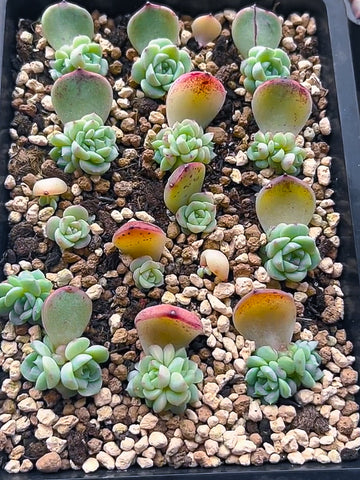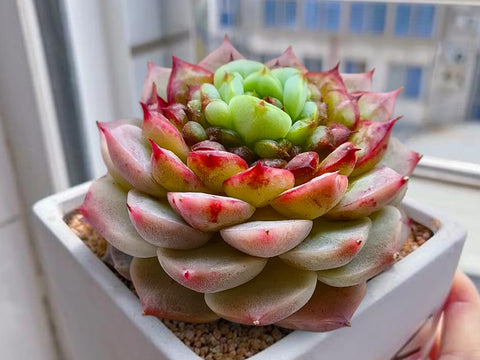Succulents often captivate with their adorable appearance, vibrant colors, and low-maintenance nature. Today, I'm introducing a succulent that embodies all three characteristics: Echeveria 'Red Velvet'. Doesn't the name remind you of a delicious red velvet cake? Like its namesake, the appearance of Echeveria 'Red Velvet' will surely win you over. The first time I saw it, I couldn't help but think: "Wow, it looks just like a red velvet cake!"
About Echeveria 'Red Velvet'
Originating from South Korea, Echeveria 'Red Velvet' appears to be a hybrid of Echeveria elegans 'hyaliana' and another species; at least, that's my best guess. It inherits the triangular-shaped leaves and slightly outward-pointing, sharp tips from Echeveria elegans 'hyaliana'. The plump leaves and raised backs make Echeveria 'Red Velvet' exceptionally full-bodied.
Compared to most succulents, Echeveria 'Red Velvet' maintains its beauty in its normal or vibrant state. Don't doubt it: under normal conditions, Echeveria 'Red Velvet' displays a translucent light green color, with a thin layer of farina on its leaves, giving it a fresh appearance. When in its vibrant state, Echeveria 'Red Velvet' undergoes a dramatic transformation. It turns pink or red altogether, with darker hues at the tips and the heart of the leaves, creating a "sugar heart" effect. Isn't it just like a red velvet cake paired with the white farina on the surface?
Generally, the more beautiful a succulent, the more demanding its care requirements. Fortunately, Echeveria 'Red Velvet' boasts strong adaptability to its environment. Even succulent beginners can find it hard to kill as long as they meet primary care needs.
How to Care for Echeveria 'Red Velvet'
Basic Care Requirements
Sunlight: 8 hours or more of indirect sunlight or direct sunlight outdoors
Temperature: Tolerates temperatures between 41-95°F (5-35°C)
Watering: Follow the "soak and dry" method
Soil: Well-draining cactus mix soil
Pot: Use pots with drainage holes
Fertilizing: Low nutrient requirements, almost no need for fertilization
Tips for Thrive Echeveria 'Red Velvet'
Echeveria 'Red Velvet' is easy to care for, but achieving that vibrant state requires extra effort. Here are some tips I've gathered:
Plenty of Direct Sunlight
Remember, outdoor sunlight is the best color enhancer for succulents. Most succulents thrive in sunlight, and Echeveria 'Red Velvet' is no exception. During spring and fall, sunlight can make it thrive. So, why don't give it a try? Find a spot in your outdoor garden where they can soak nature's gifts. After 1-2 weeks, your Echeveria 'Red Velvet' turns red. You'll thank it for the transformation. If spring is rainy, place potted Echeveria 'Red Velvet' in a spot where it gets sunlight but is sheltered from rain.
Apartment-dwelling succulent enthusiasts, don't despair. Find a good window sill with ample indirect sunlight, or invest in indoor plant shelves with professional succulent grow lights. Your Echeveria 'Red Velvet' will slowly show its colors.
You may wonder: How to choose a grow light for succulents.

Stress for Vibrant Colors
Envious of those Echeveria 'Red Velvet' flaunting their vibrant colors on social media? You can have them too, with the right temperature. Echeveria 'Red Velvet' is more likely to develop vibrant colors in early spring and winter. When the temperature difference between day and night reaches around 50°F (10°C), outdoor-grown Echeveria 'Red Velvet' easily exhibits more intense colors, also known as "stress colors."
It's hard to achieve such a large temperature difference in my area. However, I've noticed that my Echeveria' Red Velvet' displays its rare vibrant colors every early winter when the average temperature drops to 41-43°F (5-6°C). Regardless, Echeveria 'Red Velvet' has the characteristic of developing stress colors. A little more patience, and let nature and the succulent do the rest.
Watering Caution in Summer
Summer poses a significant challenge for Echeveria 'Red Velvet'. Mine tends to fade to green every summer, so I rarely give it extra water to ensure its survival. With its thick leaves and strong water retention ability, I only give it a little water when its leaves feel soft and wrinkled.
Summer Echeveria 'Red Velvet' may be disappointing. Still, as long as you endure it, it will thrive again when autumn arrives, making me fall in love with it all over again. Isn't the joy of caring for succulents all about this?
You may wonder: How to care for succulent in summer?
100% Success Rate in Propagation
Echeveria 'Red Velvet' is easy to propagate through leaf cuttings, and I've tried it myself, with a success rate of up to 100%. If you're new to succulents, experience the joy of propagation, and Echeveria 'Red Velvet' gives you the perfect opportunity. Here's a simple guide for you:
1. Obtain healthy, intact leaves from the bottom of the succulent.
2. Place the leaves on a paper towel and leave them on a windowsill.
3. After 2-3 weeks, you'll notice roots growing from the leaves.
4. Place the rooted leaves on soil in a container.
5. Wait patiently for the soil to root, and the leaves to sprout pups.
6. Gently water around the roots.
7. Once the succulent grows to around 1cm (0.4 inches), you can transplant it.
Succulent Leaf Propagation Flopped? Check Out These Common Mistakes!

FAQ
Why does my Echeveria 'Red Velvet' look somewhat mutated?
Perhaps you're referring to the protrusion in the center of the Echeveria 'Red Velvet'? This is a common occurrence in this succulent variety. It usually happens in summer when Echeveria 'Red Velvet' is actively growing. The leaves in the center grow rapidly, while the surrounding leaves can't keep up with their growth rate.
This makes Echeveria 'Red Velvet' look somewhat deformed, but don't worry too much. This variety has self-repair solid abilities, and in the subsequent growth process, the lower leaves will gradually catch up with the growth rate of the new leaves, returning to their normal shape.




























